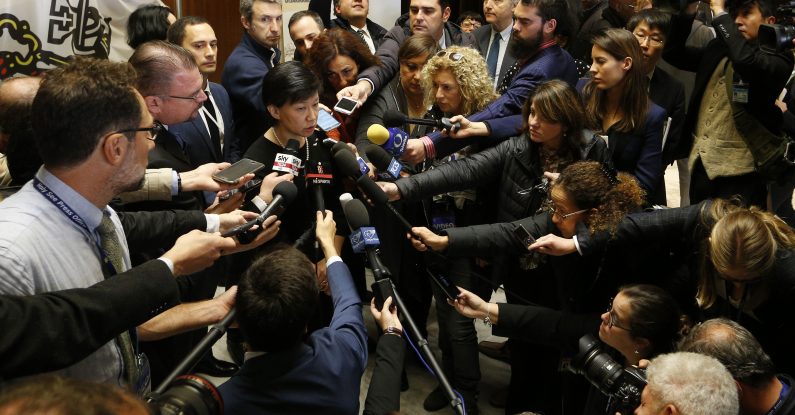
Communication with journalists is vital to get right.
It’s what we discuss every week in our communication skills training courses.
You have your key messages.
The media has their agenda.
So what’s the balance?
Read on.
A six-figure compensation settlement.
That’s the cost of hacking actor Hugh Grant’s phone.
That, and the illegality of the act, may deter The Mirror Group from doing it in the future.
But the case has an unwelcome side effect.
The further erosion of trust in journalism.
Having watched The Post this week, I savoured the other end of the journalistic spectrum.
The Washington Post stood up to a corrupt President – Richard Nixon – and published a damaging report.
It exposed the hypocritical stance of previous presidents and administrations over the Vietnam War.
A war, it’s alleged, they knew they were destined to lose.
The very existence of the Washington Post was on the line if the Supreme Court ruled against them.
But the courage shown by the editor and owner in the early ’70s meant they were then able to expose Nixon’s involvement in the Watergate break-in shortly after.
Leading to the removal of The President from office.
Normally, journalism involves simpler elements than phone hacking or the Vietnam War.
It’s a means of telling a story.
And it could be the story of your business, organisation or campaign.
That’s why we encourage our clients to engage with journalists and tell their story with enthusiasm.
The best way of avoiding mistakes is to be well-prepared.
We run our courses from our Glasgow studios or on the road.
We’ve worked in 26 countries since 1989.
Everywhere we go, we share these principles.
We need to know what’s of greatest interest to those reading, listening or watching.
So know your audience.
Next, write down your key points.
Start with your opening point, at the top of the pyramid, with what’s in it for the audience.
Work your way down the points in order of importance.
Finish with a Call to Action, telling the audience what they need to do next.
That all adds up to a Pyramid of Communication.
Prioritising your key points according to the audience of the day.

People need to “see” what you’re talking about.
But if you talk in generalities or abstract concepts, they’ll see the wrong image.
David Attenborough’s picture of a seal with its neck stuck in a ring of plastic has much more impact than the discussion of “maritime pollution”.
We have to follow that lead and give clear examples and case studies to make our point to journalists.
Now the journalist – and his/her audience – can “see” what we’re talking about.
“Do not tell me you will try”,
said Winston Churchill.
“Tell me that it is done.”
Through fear of failure, people often water down their message.
They use words like relatively, reasonably, think, hope and do our best.
Whereas people with high levels of communications skills use words of commitment.
“I’m determined…”
“We’re committed…”
“I firmly believe..”
“It’s our clear goal…”
We have to use committed language with the media in explaining our case.
A Pink Elephant means a clear and unnecessary negative.
“I’m not a quitter,”
The British Prime Minister said that in China last week.
Soon after President Donald Trump had said:
“I’m not a racist.”
But we’re left thinking only of a quitter and a racist.
We have to tell journalists what we are rather than what we’re not.
What we do believe in rather than what we don’t.
In other words – paint a positive picture rather than a negative one.
Journalists, like our own Rachael Fulton, ask questions for a living.
We need to give them direct answers.
Evasiveness is obvious to the journalist.
And it leaves the audience distrusting you.
So we need to answer yes, no, I don’t know or it’s too early to say.
Then, build a strong answer, taking it to one of our key messages, prepared for by the Pyramid of Communication.
Some politicians ignore the questions and go straight to their prepared answers.
They simply annoy the audience who appreciate certainty.
Following these five principles gives us the best possibility of correct communication with journalists.
An accurate interpretation rather than a misinterpretation.
If we achieve that, we’ll be confident of good results, rather than looking stupid over what we’ve said.
And we’ll have removed all the fears we have about dealing with the media.
Since the 1980s, I’ve plugged into the media to promote businesses, explain situations, raise money for good causes, and fight injustices.
Having done business in countries where the media is anything but free, I appreciate a free media in this country and the opportunity it provides to give us our say.
If you want any advice on taking your opportunity with the media, contact us.
Bill McFarlan is Executive Chairman of Pink Elephant Communications.
You can view his full profile here.
Photos in Communication with journalists blog by Tripsavy // the Guardian // crazyegg.co.uk // Pink Elephant Communications.
Communication with journalists blog edited by Colin Stone.
6th February 2018 Featured in: Blog, Media training blogs By: Pink Elephant
Some media trainers knock you down…and leave you down. Our media coaches show you how to deal with each knock…and still win through. So you have the presentation skills to perform – with confidence.